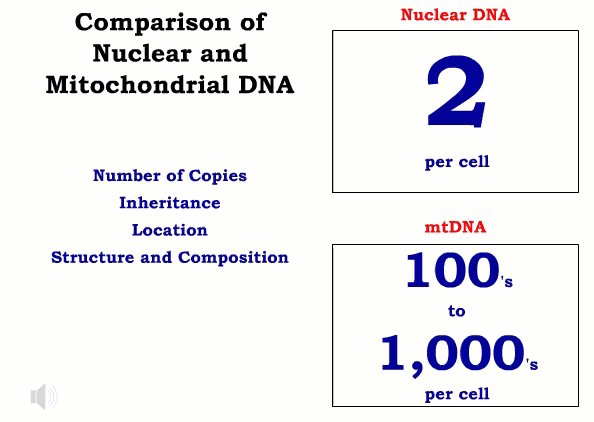Archival Notice
This is an archive page that is no longer being updated. It may contain outdated information and links may no longer function as originally intended.
Home | Glossary | Resources | Help | Contact Us | Course Map
Mitochondria are responsible for the bulk of adeosine triphosphate (ATP) synthesis and are often referred to as the energy powerhouse of the cell. They are the site of cellular respiration and capture energy generated by the breakdown of food during the oxidation of simple organic compounds.01
Mitochondria were first visualized as discrete cytoplasmic organelles in 1840, and in the 1960s it was determined that they contain their own DNA. Mitochondria are rod-shaped organelles that are present in all nucleated eukaryotic cells that use oxygen. They are approximately 1 to 10 micrometer (µm) in length and approximately 0.5 to 1.0 µm in diameter.02
A team of scientists at the Cambridge Research Institute completely sequenced the reported 16,569 bases of the mitochondrial genome (mtGenome).03 In fact, historically, this is the first component of the human genome that was completely sequenced. The DNA inside the mitochondrion is circular in structure and double-stranded. Mitochondrial DNA (mtDNA) codes for 13 polypeptides required for oxidative phosphorylation, 22 transfer RNAs, and 2 ribosomal RNAs. The heavy strand is purine rich, and the light strand is pyrimidine rich. Many scientists, especially evolutionary biologists, attribute the origin of the mitochondrion as a primitive aerobic bacterium that was once engulfed by the ancestor of present-day eukaryotic cells.04,05
The mtGenome is not subjected to recombination during sexual transmission. The mtGenome is strictly maternally inherited; progeny of both males and females inherit the mtDNA from their mother (barring mutations), whereas only the daughter passes on the mtDNA to the next generation. The sperm contributes no mtDNA when fertilizing the egg. Biological maternal relatives all share their mtDNA, yet their nDNA is unique. The evolution of mtDNA has been studied in such detail that evolutionary biologist have determined that the Mother Eve of all surviving mtDNA profiles lived in Africa between 140,000 and 290,000 years ago. The low fidelity of mtDNA polymerase, lack of proof-reading, and the apparent lack of mtDNA repair mechanisms have led to a higher rate of mutation in the mtGenome as compared to the nuclear genome. Some regions of the mtGenome appear to be evolving at five to ten times the rate of single copy nuclear genes.06
The displacement loop, or D-loop, is a non-coding segment of the mtGenome that maintains elements for initiation of transcription and replication but does not code for any gene products. It is the D-loop region of the mtGenome that the forensic community routinely sequences for forensic casework. The D-loop is 1.1 Kb and is often referred to as the control region. Since the D-loop is a non-coding segment of DNA, variability within it is not lethal to the growing fetus. It is this nucleotide, or base, variability that is significant to the forensic scientist.07 Differences are observed between individuals not of the same maternal line.
Additional Online Courses
- What Every First Responding Officer Should Know About DNA Evidence
- Collecting DNA Evidence at Property Crime Scenes
- DNA – A Prosecutor’s Practice Notebook
- Crime Scene and DNA Basics
- Laboratory Safety Programs
- DNA Amplification
- Population Genetics and Statistics
- Non-STR DNA Markers: SNPs, Y-STRs, LCN and mtDNA
- Firearms Examiner Training
- Forensic DNA Education for Law Enforcement Decisionmakers
- What Every Investigator and Evidence Technician Should Know About DNA Evidence
- Principles of Forensic DNA for Officers of the Court
- Law 101: Legal Guide for the Forensic Expert
- Laboratory Orientation and Testing of Body Fluids and Tissues
- DNA Extraction and Quantitation
- STR Data Analysis and Interpretation
- Communication Skills, Report Writing, and Courtroom Testimony
- Español for Law Enforcement
- Amplified DNA Product Separation for Forensic Analysts



